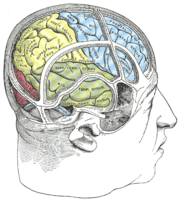
Photo from wikipedia
Unilateral spatial neglect is a disorder of higher brain function that occurs after a brain injury, such as stroke, traumatic brain injury, brain tumor, and surgical procedures etc., and leads… Click to show full abstract
Unilateral spatial neglect is a disorder of higher brain function that occurs after a brain injury, such as stroke, traumatic brain injury, brain tumor, and surgical procedures etc., and leads to failure to attend or respond to stimuli presented to the side contralateral to the lesioned cerebral hemisphere. Because patients with this condition often have other symptoms due to the presence of several brain lesions, it is difficult to evaluate the recovery mechanisms and effect of training on unilateral spatial neglect. In this study, a mouse model of unilateral spatial neglect was created to investigate whether the size of the lesion is related to the severity of ipsilesional spatial bias and the recovery process. Focal infarction was induced in the right medial agranular cortex (AGm) of mice via photothrombosis. After induction of cerebral infarction, ipsilesional spatial bias was evaluated for 9 consecutive days. The major findings were as follows: (1) unilateral local infarction of the AGm resulted in ipsilateral bias during internally guided decision-making; (2) the lesion size was correlated with the degree of impairment rather than slight differences in the lesion site; and (3) mice with anterior AGm lesions experienced lower recovery rates. These findings suggest that recovery from ipsilesional spatial bias requires neural plasticity within the anterior AGm. This conditional mouse model of ipsilesional spatial bias may be used to develop effective treatments for unilateral spatial neglect in humans.
Journal Title: Behavioural Brain Research
Year Published: 2021
Link to full text (if available)
Share on Social Media: Sign Up to like & get
recommendations!